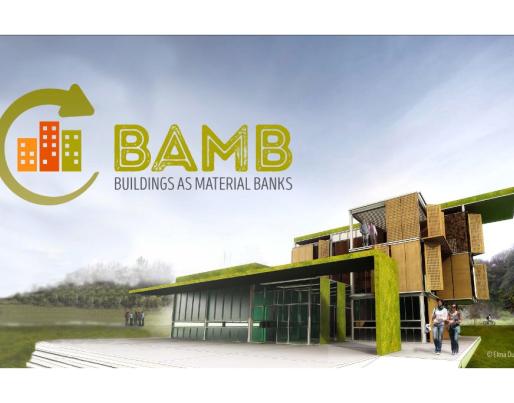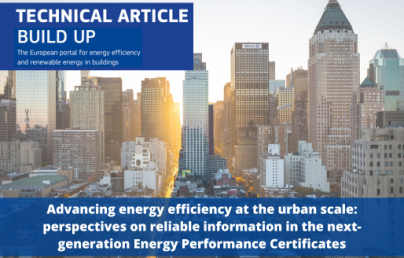
Environmental footprint and circularity in the construction sector

Environmental footprint and circularity in the construction sector
Perspective Overview of BAMB H2020 Project: Environmental footprint and circularity in the construction sector.
While focusing in energy efficiency of buildings, Build UP portal acknowledge the relevance of an integrated approach to the overarching goal of reducing environmental footprint of buildings. The rational and efficient use of materials and construction systems and the minimization of waste production from the construction sector are essential target areas with high potential of amelioration of critical indicators. Energy use and greenhouse gas emissions topics are directly and indirectly addressed when analysing construction processes and materials’ life cycles. These studies and practices might be understood inscribed into the cutting-edge concepts of Urban Metabolism, Cradle to Cradle or Circular Economy as well as key goals and programmes of the UN 2030 Sustainable Development agenda.
The EU H2020 funded project BAMB “Buildings as Material Banks”, coordinated by IBGE-BIM Brussels Environment, gathers 15 partners from seven countries and it is running since 09/2015 until 02/2019 developing a rich body of experiences, pilot projects and concrete tools. The overall goal of the project is to foster a paradigm shift in which materials, components and buildings are evaluated and conceived taking into consideration the potentiality and requirements of a pertinent and effective “Circularity”. This approach is meant to go beyond the somewhat limited and linear life-cycles-analysis (LCA, LCC) approaches that are used —if used— in the tools and methodologies available today for the construction sector.
Recently, the progress status of BAMB project was presented in a seminar day in Brussels along with the input of the One Planet Network implementing the UN 2030 sustainability goals in synergy with BAMB’s objectives. This event was an opportunity to draw up an overview of the arising crucial questions, pilot projects, experiences and tools being tested and developed aiming to favour the circularity paradigm. All the aforementioned, focusing in the European Union context, whose leading position in the field is highly appreciated.
BAMB PROJECT - STRUCTURE & TOOLS
The BAMB project is structured in interlinked work-packages along the two basic axes of Buildings and Materials. Each one of these axes correspond to an operative tool: (1) the “Materials Passports” and (2) the “Reversible Building Design assessment”. These tools are themselves connected through a “Circular Building Assessment” tool (3) with the overall goal of attaining a Circular Value Network that would be supported by new business models, new management and procurement methodologies and policy suggestions. The implementation of BAMB core tools is foreseen to be operational by means of BIM data management processes that are meant to allow end-user-friendly interfaces.
Each of the BAMB project tools are in different development and testing phases and are themselves object of independent study integrated within the State of the Art analysis and investigation carried out as a fundamental mission of the project.
Materials Passports
Although the term passport has been largely used associated to building for the past three decades, BAMB project has related it at materials and products level to define the “sets of data describing defined characteristics of materials in products that give them value for recovery and reuse”. (Luscuere, EPEA 2016/ Hansen et al., 2012)
This strategically structured data tool - with the potential to incorporate existing standards and mechanisms source of relevant information to circularity - is meant to support reversible design, to entice innovation and to facilitate circular-sound choices for designers as well as for clients, developers and managers. It would also allow creating incentives for manufacturers and suppliers to integrate circularity in their practices – e.g. benefiting from visibility and benchmarking.
Within the project, it is envisioned to develop a body of 300 entries-passports with a software/ platform interface that would facilitate accessibility for all stakeholders throughout the value chain of a building. A prototype of the platform is being tested and available already for consultation and for interested manufacturers for potential participation.
Reversible Building Design
This concept alludes to buildings in which the deconstruction or dismantling are strategically foreseen, or where components can be removed or added while maintaining building's integrity. “BAMB Reversible Design tools will inform designers and decision makers about the transformation capacity, reuse potential and the impacts of design solutions during the conceptual design phase and throughout the buildings entire life cycle” (BAMB2020, 2016)
These principles aim to enable flexible use buildings that are easy to transform and refurbish, that allow cost efficient maintenance and repair as well as efficient recovery of its materials and components while waste production is kept at its minimum.
In practical terms, in BAMB project this tool is developed as a Design Protocol for dynamic & circular building that is meant ”to enable different stakeholders in the construction value chain to implement Reversible Design strategies and approaches in construction and refurbishing activities” (BAMB2020, 2016). This protocol integrates the principles and main criteria for the design of transformable buildings with reusable components into building transformation models with a set of design indicators pointing out the relevant design aspects and decisions for each design phase.
Circular Building Assessment
Aiming to support a circular sound resource effective decision-making in the architecture engineering and construction sector, BAMB project tackles to develop a Building Level Integrated Decision Making Model. It is meant as an effective and practical way for developers and designers to compare outcomes of design and material choices in order to make informed decisions.
“The model is a methodology whereby new buildings and existing buildings can be assessed for resource productivity, based upon material selection and design decisions”. (BAMB2020, 2016)
“A selected subset of this model will be developed into a BIM compliant resource productivity prototype. The ambition is to provide a useful prototype as a proof of concept of how the assessment and decision-making model could aid real world BIM users in making better choices and designs to enhance reuse potential and transformation capacity through the different phases of the life cycle of the building (design, construction, management & maintenance, refurbishing, dismantling)”. (BAMB2020, 2016)
The BIM Resource Productivity Prototype would be delivered as a Beta-version software interacting with a BIM model and BAMB datasets or other data sources assessing of the reuse potential based upon design decisions and material selection criteria. An additional data layer informing on resource productivity is then created and used as a performance parameter.
BAMB PROJECT – CASE STUDIES & PILOT EXPERIENCES
An integral, practical and visible element of BAMB project are undergoing prototypes and pilot building experiences where principles and tools are being tested and showcased.
There are 6 projects of a rich diversity of programmes and scopes:
- EFP educational and showcase tool/module B.R.I.C. for Build Reversible In Conception.
- Green Transformable Building Lab (GTBL) project and organisation that is partner itself of BAMB.
- RAG Montan Immobilien GmbH “New Office Building” in Essen, DE.
- Circular Retrofit Lab of 8 modules of student rooms in VUB university in Brussels, BE.
- The itinerant exhibition Reversible Experience Modules (REMs).
- The Sarajevo Green Design Centre, building that would develop through transformation stages. BA.
Advancement reports have been published, and divulgation events of these experiences organized. Further formal feedback would be gathered when conclusions would be available and presented in early 2019 – along with the outcome of the student’s BAMB Reversible Design Competition –, when this H2020 project would be coming to its end. Build UP portal will be following. Then most of the pilot projects will continue the circular life of their own!
FUTURE PERSPECTIVES AND CHALLENGES
While the pertinence of the goals and approaches and even the vision and principles supporting BAMB project might be of general acceptance and appreciated as concrete ways to go forward in ensuring the reduction of the environmental footprint of the building sector, there is also consensus on weighty challenges on the way to effectively achieve the envisioned tipping point and paradigm shift.
Namely, the application of the methodologies and principles at the level of the mainstream market is a scaling up of vast proportions. Accordingly, it requires strategic efforts at different stakeholders’ levels and long-term considerations. This is coherently tackled within the BAMB project by addressing notably the fields of new procurement and business models, as well as the field of policies and standards with their crucial role in the development of industry and economy. This is done taking into consideration from the local level, to regional, national and international levels where compatible and scale-strategic interactions are to be coordinated.
Besides the scale/size issue of the market where the change of principles is to be implemented, there is the nature of the change itself. These principles and considerations, meant to ensure circularity in the built environment, imply adjustments and changes where efficiency may differ from or be contradictory with profit and productivity logics for manufacturers or developers – logics that are sustained by current policies, market and industry parameters. Furthermore, this sort of conflict of interest may be stretched deeper into the industry and economic models, considering that a way to reduce waste production or resource needs is not only efficiency and simplicity but sobriety and restrain – relating to “Negawatt” principles for energy use. These are “degrowth” paradigm-shift questions, complementary to the Circular Economy vision for the built environment, that may enrich the approach to circularity sound policies and business-models reflections and proposals.
Other key challenges to tackle to allow the proper and large-scale implementation of the tools and principles, relates to the data its self, basic input to the tools and the (IT) management of this data.
Notably the transparency and standardisation of information on products and materials is a basic requirement that is not integrated in current day practices and may encounter some resistance when facing industrial secrecy or patent rights sensible points. The progressive scaling-up of circular-industry practices should take care of overcoming these resistances while the role of the regulation and policies is again underlined.
In terms of data management, even if it’s clear that BIM wise tools and methodologies are not goals themselves but means to achieve the core objectives of circularity… these information technology tools become indispensable enablers. BIM methodology is rapidly evolving and becoming more of a common practice in the construction sector, mostly applying although to a certain kind/scale of projects, whereas a large part of the market of small-scale construction and renovation remains in marge of the formal BIM scope. It is important to take into consideration this broad sub-sector with a specific approach for an effective and appropriate implementation of “circularity” practices.
In the other side of the spectrum, where BIM practices are easily being integrated, we find the large-scale civil construction or technological infrastructure projects, where high environmental impact and resource productivity improvement are at stake. Hence this is a sub-sector that should pertinently be addressed within the scope of models, tools and policies addressing constructions as Material Banks of a circular-industry.
There is finally the overarching issue of “communication” to address at different levels in the context of Circularity in general and the context of the BAMB project in particular. It is well noted, within the different fronts of work of the project, that participation and implication of all stakeholders is crucial to moving forward towards the goals -that are interdisciplinary in nature. This translates, at the scale of a concrete construction project, into the “circular procurement approach” where, as for general “integrative design” principles, it is of key importance that all participants coordinate and communicate from early stages of the project.
In more general terms, the communication about the BAMB project itself towards the targeted construction sector professionals, and even toward general public, is also of strategic importance and has indeed not being neglected within the development of this H2020 project. Internet interface, social media, visual communication and product placement have been put forward. While formal research and structured efforts sustain the core projects, this visibility and attractiveness is a driving factor, contributing to federate participants and to general awareness. These are somewhat abstract, emotional and qualitative elements that become essential too, to entice and attain paradigm shifts.

